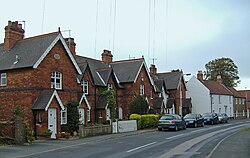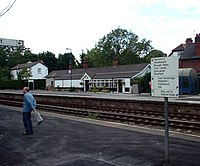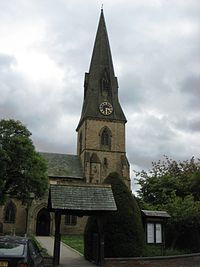North Ferriby
| North Ferriby | |
| Yorkshire East Riding | |
|---|---|
 High street | |
| Location | |
| Grid reference: | SE985258 |
| Location: | 53°43’12"N, -0°30’28"W |
| Data | |
| Population: | 3,893 (2011) |
| Post town: | North Ferriby |
| Postcode: | HU14 |
| Dialling code: | 01482 |
| Local Government | |
| Council: | East Riding of Yorkshire |
| Parliamentary constituency: |
Haltemprice and Howden |
North Ferriby is a village in the East Riding of Yorkshire. It stands on the north bank of the Humber Estuary, approximately eight miles west of Kingston upon Hull city centre. To the north, atop a hill, stands Swanland. Melton is close by to the west.
Directly opposite the village, on the south bank of the Humber in Lincolnshire is South Ferriby. North Ferriby is generally referred to as "Ferriby" by locals on the north bank, except where confusion might arise.
Ferriby parish had a population of 3,893 recorded in 2011.

The village is served by Ferriby railway station which is on the Selby Line.
Parish church
The village church, All Saints, has a distinctive spire, designed by John Loughborough Pearson, R.A. (1817–97). The church was completed in 1848. Today it is a Grade II listed building.[1] The current vicar is Reverend Matthew Brailsford. The parish used to have extensive holdings, including St Mary Lowgate in Hull.
A wooden church was built in the Anglo-Saxon period was replaced by the village’s first stone church around 1150.
History
Humber Estuary
"The archaeology of the intertidal wetlands of the Humber Estuary is of international importance, and includes prehistoric boats, trackways, fishtraps and platforms, Roman settlements and ports and Post-Mediæval fishweirs."[2]
The foreshore of North Ferriby, within the Humber Estuary, is the site of the earliest sewn plank boats known outside Egypt.[3] In 1931, wooden planks belonging to an ancient boat were discovered by local man Ted Wright on the shore of the Humber. Two further boats have since been discovered. Estimates using radiocarbon dating have placed the origin of the boats to the Bronze Age, between 2030 and 1680 BC. The Ferriby Boats are the earliest known boats found in Europe.
In addition, Bronze Age round barrows were found near North Ferriby by archaeologists excavating the land on which the A63 road|A63 junction was built. There was also evidence of Iron Age and early Romano-British activity in that area.

Ferryby is believed to have ben founded by Scandinavian settlers, is its name is from the Danish ‘’Ferja bi’’ (place by a ferry),
Ferriby Priory
The village was once significant for Ferriby Priory, around 1160, of the order of Knights Templar, founded by Lord Eustace Broomfleet de Vesci,[4] in the reign of King John, anno 1200, as appears from an ancient manuscript formerly in the possession of the late Luke Lillingston, Esq. of North Ferriby, the Owner of the priory. It was dissolved along with the lesser monasteries, in 1536. The site of this priory is said to have been in the possession of 100 different persons "in the space of no more than 130 years after its dissolution".
The village has, in succession, been the patrimonial possession of the Mortimers, the Poles and the Bacons. It retains the elements of several elegant mansions from about 1750 as Hull merchants started to build large houses (such as Ferriby House) with cottages for workers.
About the village
The village has a pub, the Duke of Cumberland, a British Legion club, a range of local shops, a squash club with three courts, village hall and parish hall.
A public footpath that forms part of the Trans Pennine Trail and the Yorkshire Wolds Way, runs from Ferriby to Hessle alongside the Humber estuary, with views of the Humber Bridge. On this path is the site where the Ferriby Boats were found.
Outside links
| ("Wikimedia Commons" has material about North Ferriby) |
- North Ferriby Parish Council
- ferriby North Ferriby in the Domesday Book
- All Saints' Church
- Primary school
- A vision of Britain through time
- Information on North Ferriby from GENUKI
References
- ↑ National Heritage List 1347004: Church of All Saints (Grade II listing)
- ↑ van de Noort, Robert; Ellis, Stephen (2000). The Humber estuary: managing the archaeological resource in a dynamic environment.. Geological Society, London, Special Publications 175, no. 1. pp. 419–427. https://scholar.google.com/scholar?q=Humber+bronze+age+Kilnsea+boat&btnG=&hl=en&as_sdt=0%2C5.
- ↑ Chapman, Henry P.; Chapman, Philip R. (2005). "Seascapes and Landscapes—the Siting of the Ferriby Boat Finds in the Context of Prehistoric Pilotage". International Journal of Nautical Archaeology 34 (1): 43–50. doi:10.1111/j.1095-9270.2005.00042.x.
- ↑ Beck, Egerton (1911). "The Order of the Temple at North Ferriby". The English Historical Review 26 (103): 498–501. https://zenodo.org/record/1543643/files/article.pdf.
- Gazetteer — A–Z of Towns Villages and Hamlets. East Riding of Yorkshire Council. 2006. p. 8.
